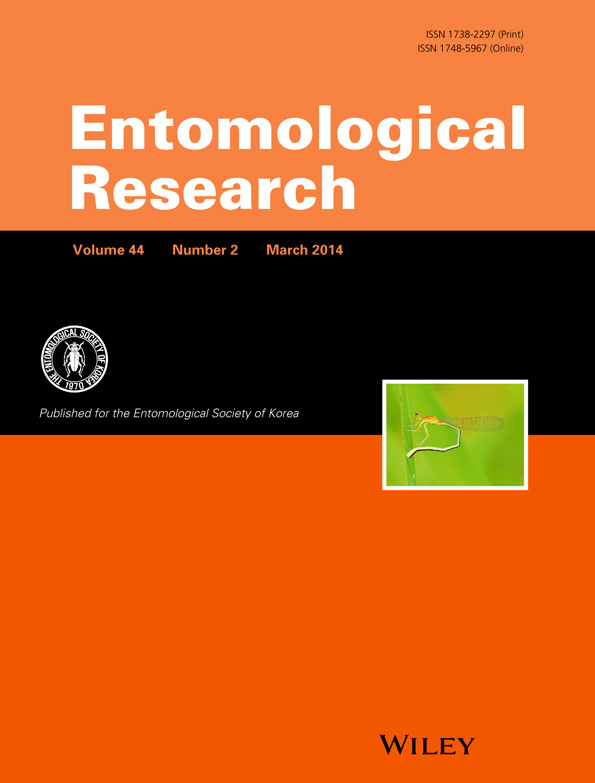Snow craneflies of the Genus Chionea Dalman (Diptera: Limoniidae) from Korea
Abstract
The Korean snow cranefly genus Chionea Dalman is reviewed taxonomically. Four species are identified: C. crassipes Boheman, C. kanenoi Sasakawa, C. mirabilis Vanin and C. deogyusana sp. nov. Among them, C. deogyusana sp. nov. is new to science, and C. kanenoi is reported for the first time in Korea. A key to Korean species and photographs of external features are given.
Introduction
Snow craneflies of the genus Chionea are characterized by the complete reduction of their wings and by the vivid activity of adults during the freezing season. They are distributed throughout most of highlands in Holoarctic region, while only the following nine species are known to be endemic to Far East Asia: Chionea araneoides Dalman, C. kanenoi Sasakawa, C. crassipes Boheman, C. magadanensis Narchuk, C. nipponica Alexander, C. pusilla Savchenko, C. mirabilis Vanin, C. sphaerae Zhang et al. and C. tianhuashana Zhang et al. (Narchuk 1998; Zhang et al. 2012). Although Alexander (1936) described C. gracilistyla based on specimens from both Japan and the Tururinka Mountains in the Amur Region, it had been treated as a race or a subspecies of C. crassipes by Savchenko (1983). However, it was synonymized again with the latter species by Savchenko et al. (1992). Later, Narchuk (1998) and Oosterbroek (2008) subdivided C. crassipes into two subspecies, gracilistyla Alexander and magadanensis Narchuk from Far East Asia.
Hitherto, the fauna of snow craneflies have been very poorly known in the Korean peninsula. As far as we know, the first record of the genus from Korea was made by Savchenko et al. (1992), who reported Chionea crassipes crassipes from North Korea. Thereafter, Vanin (2008) reported a new species, C. mirabilis, along with the recorded species, C. crassipes from Mt. Deogyusan in South Korea. Therefore, only two species have been hitherto listed in Korean fauna. Indeed, live adults of the former species, C. mirabilis, walking around the peak of the same mountain covered with snow in February, were reported in a Korean newspaper (Yeonhap News 1999) accompanied by the authors’ explaining the unique life history of this winter insect. The discovery and observation of the unknown snow cranefly was subsequently also introduced in the annual meeting of the Korean Entomological Society (Kwon & Suh 1999).
Among the four Korean Chionea species treated in the present study, C. deogyusana sp. nov. is new to science, and C. kanenoi is reported for the first time in Korea.
The collection site is shown in Figure 1. All the voucher specimens examined in the present study are deposited in the collection of the School of Applied Biosciences at Kyungpook National University, Daegu, Korea.

Collecting site at Deogyusan (Manseonbong ski slope, 1200–1300 m a.s.l.), Muju-gun, Jeollabuk-do, Korea.
Systematic accounts
Key to species of the genus Chionea from Korea
- 1
Tibiae enlarged apically………..2
- –
Tibiae not enlarged apically………3
- 2
Femora enlarged, maximum diameter more than 0.2 times the length. Gonocoxite very stout……….C. mirabilis Vanin
- –
Femora enlarged, maximum diameter less than 0.2 times the length. Gonocoxite prolate……….C. deogyusana sp. nov.
- 3
Antennae with 7 antennomeres………C. crassipes Boheman
- –
Antennae with 11 antennomeres…….C. kanenoi Sasakawa
Chionea (Chionea) crassipes Boheman, 1846 (Figs 2, 6A)
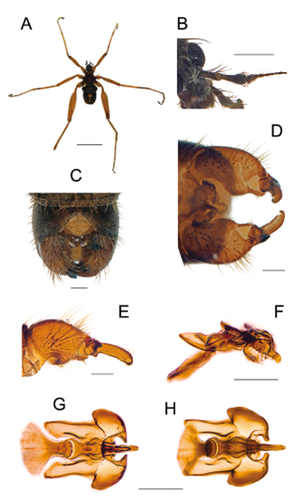
Chionea crassipes (male). (A) habitus; (B) antenna; (C) last abdominal segments, dorsal view; (D) basistyle, dorsal view; (E) ditto, lateral view; (F) hypandrium, lateral view; (G) ditto, dorsal view; (H) ditto, ventral view. Scale bar, (A) 1 mm; (B) 0.5 mm; (C–H) 0.2 mm.
Chionea crassipes Boheman, 1846: 179 (Type-locality: Sweden).
Chionea crassipes crassipes: Savchenko et al., 1992: 244.
Chionea (Chionea) crassipes: Vanin, 2008: 414.
Diagnosis
Antenna with 7 antennomeres. Tibiae not enlarged apically. Basal teeth of gonostylus bidentate, inner tooth shorter than outer. Aedeagus projecting beyond paramere.
Description
General coloration yellowish brown; head including palpus dark brown; antenna dark brown; thorax, abdomen and legs brown; degenerated wings and halters white brown (Fig. 2A).
Head spherical, slight higher than long in profile; vertex and clypeus with long dark brown bristles; palpus with 4 palpomeres, subequal to each other in length and bristled. Antenna with cylindrical scape, about 2.0 times as long as wide; pedicel distally enlarged, about 1.1 times as long as scape; fusion segment short and broadly conical, a little more than one-third length of pedicel; 4 additional flagellomeres short cylindrical with two long setae, relative length as 7 : 8 : 7.7 : 4 (Fig. 2B).
Thorax with humped mesonotum in lateral aspect, anterior slope nearly perpendicular to pronotum; pronotum and central mesonotum with numerous long and erected setae; scutellum with long marginal setae; pleura not setose; halter white brown; wing degenerate, rattail shaped, about 1.3 times as long as halter. Legs long pubescence and brown; femora with long light brown setae shorter than as diameter of femur; tibiae with long light brown setae; tarsomeres beyond basitarsus darkening, basitarsus very slender, slight longer than the total length of the other tarsomeres, third tarsomere somewhat humped at ventral subapex, fourth tarsomere bearing proximal tubercle.
Abdomen with long tergal and sternal setae chiefly near posterior margin, most dense on posterolateral corners. Gonocoxite prolate in profile (Figs 2C–E). Gonostylus slender and cylindrical, expanded and rounded apically, distal end with tuft of setulae; basal teeth bidentate, inner tooth shorter than outer (Figs 2D–E). Paramere curved inward apicad; claspette apically rounded; aedeagus protruding beyond paramere (Figs 2F–H).
Body length: male 3.2–4.1 mm; female 3.6–3.9 mm.
Material examined
1 male, Deogyusan (Manseonbong ski slope, 1200–1300 m a.s.l.), Muju-gun, Jeollabuk-do, Korea, 15.ii.1999; 3 males, 2 females, same locality, 22.ii.2013; 1 female, same locality, 8.iii.2013.
Distribution
Korea, China, Japan, Russia, Europe.
Chionea (Chionea) deogyusana sp. nov. (Figs 3, 6B)
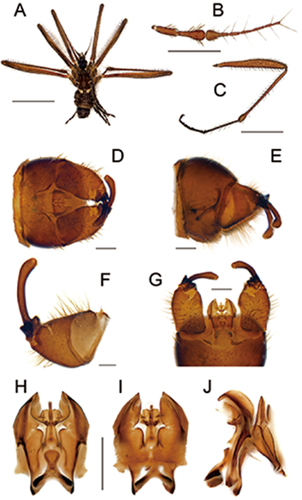
Chionea deogyusana sp. nov. (male). (A) habitus; (B) antenna; (C) hind leg; (D) last abdominal segments, dorsal view; (E) ditto, lateral view; (F) gonostylus and gonocoxite, ventrolateral view; (G) basistyle, dorsal view; (H) hypandrium, dorsal view; (I) ditto, ventral view; (J) ditto, lateral view. Scale bar, (A,C) 2 mm; (B,D–J) 0.2 mm.
Diagnosis
Antenna with 9–10 antennomeres. Femora enlarged, maximum diameter less than 0.2 times the length; tibiae enlarged apically. Gonocoxite prolate. Basal teeth of gonostylus bidentate, inner tooth as long as outer. Aedeagus not projecting beyond paramere.
Description
General coloration yellowish brown; head including palpus dark brown; antenna brown; thorax, abdomen and legs brown; degenerated wings and halters light brown (Fig. 3A).
Head spherical, slight higher than long in profile; vertex and clypeus with long brown bristles; palpus with 4 palpomeres, subequal to each other in length and bristled. Antenna with cylindrical scape, about 2.8–3.0 times as long as wide; pedicel distally enlarged, about 1.2–1.3 times as long as scape; fusion segment short and broadly conical, about half of pedicel length; 6–7 additional flagellomeres short cylindrical with long apical setae (Fig. 3B).
Thorax with conspicuously humped mesonotum in lateral aspect, anterior slope nearly perpendicular to pronotum; pronotum and central mesonotum with numerous long and erected setae; scutellum with long marginal setae; pleura not setose; halter light brown; wing degenerate, rattail shaped, about 1.5 times as long as halter. Legs long pubescence; coxae and trochanters brown to dark brown. Femora enlarged, maximum diameter less than 0.2 times the length, with long light brown setae. Tibiae enlarged apically, tibial setae longer than diameter of tibia. Tarsomeres darkening; basitarsus very slender, slight longer than the total length of the other tarsomeres; third basal tarsomere humped at ventral subapex; fourth tarsomere bearing proximal tubercle (Fig. 3C).
Abdomen with long tergal and sternal setae chiefly near posterior margin, most dense on posterolateral corners. Gonocoxite prolate (Figs 3D–E); gonostylus slender and cylindrical, expanded and rounded apically with tuft of setulae; 2 basal teeth and a small tubercle, inner tooth as long as outer (Figs 3F–G). Paramere curved inward apicad and converged toward the aedeagus which not protruding beyond the level of paramere; claspette apically rounded (Figs 3H–J).
Body length: male 2.3–2.9 mm.
Material examined
Holotype male: Deogyusan (Manseonbong ski slope, 1200–1300 m a.s.l.), Muju-gun, Jeollabuk-do, Korea, 22.ii.2013; paratype: 1 male, same data as holotype.
Etymology
The specific name refers to the type locality.
Remarks
This new species is closely allied to C. mirabilis Vanin and C. sphaerae Zhang et al. in male genitalic characters and having tibiae enlarged apically. However, the former has distinct differences with small size (2–3 mm), slender femora of which maximum diameter is less than 0.2 times the length, and parameres much narrowing toward base. Also, the new species differs from C. mirabilis by the gonocoxite being slender and prolate, and differs from C. sphaerae by the posterior margin of tergite IX being nearly straight and the paramere at the apex much broader.
Chionea (Chionea) kanenoi Sasakawa, 1986 (Figs 4, 6C)

Chionea kanenoi (male). (A) habitus; (B) antenna; (C) basistyle, dorsal view; (D) ditto, lateral view; (E) hypandrium, lateral view; (F) ditto, dorsal view; (G) ditto, ventral view. Scale bar, (A,B) 1 mm; (C–G) 0.2 mm.
Chionea kanenoi Sasakawa, 1986: 1 (Type-locality: Dosenbo, Japan).
Diagnosis
Antenna with 11 antennomeres. Tibiae not enlarged apically. Basal teeth of gonostylus truncate apically. Aedeagus not projecting beyond paramere.
Description
General coloration yellowish brown; head including palpus brown; antenna dark brown; thorax, abdomen and legs brown; degenerated wings and halters white brown (Fig. 4A).
Head spherical, slight higher than long in profile; vertex and clypeus with long dark brown bristles; palpus with 4 palpomeres, subequal to each other in length and bristled. Antenna with cylindrical scape, about 2.0 times as long as wide; pedicel distally enlarged, about 1.6 times as long as scape; fusion segment short and broadly conical, a little more than one-third length of pedicel; 8 additional flagellomeres short cylindrical with long setae (Fig. 4B).
Thorax with humped mesonotum in lateral aspect, anterior slope nearly perpendicular to pronotum; pronotum and central mesonotum with numerous long and erected setae; scutellum with long marginal setae; pleura with 2–3 setae only near coxae; halter light brown; wing degenerate, rat-tail shaped, longer than surrounding hairs, about 0.7 times as long as halter. Legs long pubescence and brown; femora with long light brown setae shorter than as diameter of femur; tibiae with long light brown setae; tarsomeres beyond basitarsus darkening, basitarsus very slender, subequal to the total length of the other tarsomeres, third tarsomere somewhat humped at ventral subapex, fourth tarsomere bearing proximal tubercle.
Abdomen with long tergal and sternal setae chiefly near posterior margin, most dense on posterolateral corners. Gonocoxite prolate in profile (Figs 4C–D). Gonostylus slender and cylindrical, expanded and rounded apically, distal end with tuft of setulae; basal teeth truncate apically and nearly bidentate, inner tooth shorter than outer. Paramere curved inward apicad; claspette apically rounded; aedeagus protruding beyond paramere (Figs 4E–G).
Body length: male 1.7 mm; female 3.0 mm.
Material examined
1 male, Deogyusan (Manseonbong ski slope, 1200–1300 m a.s.l.), Muju-gun, Jeollabuk-do, Korea, 22.ii.1999; 5 males, 1 female, same locality, 22.ii.2013.
Distribution
Korea (new record), Japan.
Chionea (Chionea) mirabilis Vanin, 2008 (Figs 5, 6D)
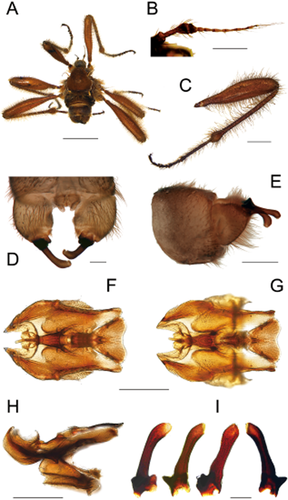
Chionea mirabilis (male). (A) habitus; (B) antenna; (C) hind leg; (D) basistyle, dorsal view; (E) ditto, lateral view; (F) hypandrium, dorsal view; (G) ditto, ventral view; (H) ditto, lateral view; (I) gonostylus. Scale bar, (A) 2 mm; (B–C) 1 mm; (D) 0.2 mm; (E) 0.5 mm; (F–J) 0.2 mm.
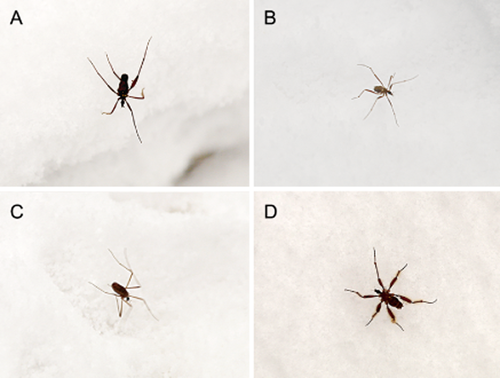
Snow craneflies walking on snow. (A) Chionea crassipes; (B) C. deogyusana sp.nov.; (C) C. kanenoi; (D) C. mirabilis.
Chionea (Chionea) mirabilis Vanin, 2008: 413 (Type locality: Togyusan, Korea).
Chionea sp. nov.: Kwon & Suh, 1999: 33.
Diagnosis
Antenna with 10 antennomeres. Femora enlarged, maximum diameter more than 0.2 times the length; tibiae enlarged apically. Gonocoxite stout. Basal teeth of gonostylus bidentate, inner tooth as long as outer. Aedeagus not projecting beyond paramere.
Description
General coloration yellowish brown; head including palpus dark brown; antenna brown; thorax, abdomen and legs brown; degenerated wings and halters light brown (Fig. 5A).
Head spherical, slight higher than long in profile; vertex and clypeus with long brown bristles; palpus with 4 palpomeres, subequal to each other in length and bristled. Antenna with cylindrical scape, about 2.5–3.0 times as long as wide; pedicel distally enlarged, about 1.2–1.4 times as long as scape; fusion segment short and broadly conical, a little less than one-third length of pedicel; 6–7 additional flagellomeres short cylindrical with long apical setae (Fig. 5B).
Thorax with conspicuously humped mesonotum in lateral aspect, anterior slope nearly perpendicular to pronotum; pronotum and central mesonotum with numerous long and erected setae; scutellum with long marginal setae; pleura not setose; halter light brown; wing degenerate, rat-tail shaped, about 1.5 times as long as halter. Legs long pubescence; coxae and trochanters brown to dark brown. Femora enlarged, maximum diameter more than 0.2 times the length, with long light brown setae nearly as long as diameter of femur. Tibiae enlarged apically, tibial setae longer than diameter of tibia. Tarsomeres darkening; basitarsus very slender, slight longer than the total length of the other tarsomeres; third basal tarsomere humped at ventral subapex; fourth tarsomere bearing proximal tubercle (Fig. 5C).
Abdomen with long tergal and sternal setae chiefly near posterior margin, most dense on posterolateral corners. Gonocoxite stout, oval in profile (Figs 5D–E); gonostylus slender and cylindrical, expanded and rounded apically with tuft of setulae; 2 basal teeth and a small tubercle, inner tooth as long as outer (Fig. 5I). Paramere curved inward apicad and converged toward the aedeagus which not protruding beyond the level of paramere; claspette apically rounded (Figs 5F–H).
Body length: male 3.6–4.3 mm.
Material examined
1 male, Deogyusan (Hyangjeokbong 1520 m a.s.l.), Muju-gun, Jeollabuk-do, Korea, 15.ii.1999; 6 males, Deogyusan (Manseonbong ski slope, 1200–1300 m a.s.l.), Muju-gun, Jeollabuk-do, Korea, 22.ii.2013.
Distribution
Korea.
Acknowledgments
This research was supported by Kyungpook National University Research Fund, 2013.



